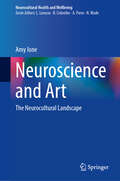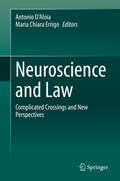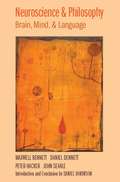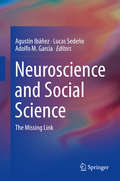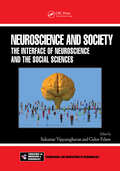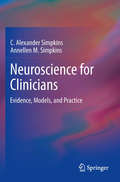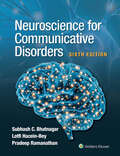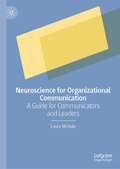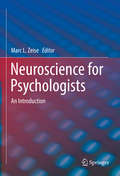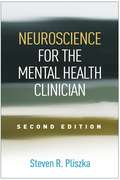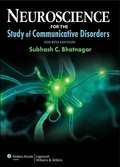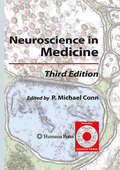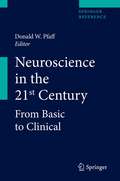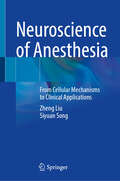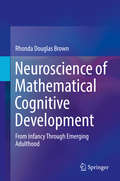- Table View
- List View
Neuroscience Nursing
by Sue Woodward Ann-Marie Mestecky"Superior... An important resource for nurses"Shanne McNamara, Vice President, British Association of Neuroscience NursesNeuroscience Nursing is a comprehensive, practical text that reflects both the richness and the diversity of contemporary neuroscience nursing. It aims to inform the practice of neuroscience nursing through the report of current research, best available evidence, policy and education.This important new book is divided into several sections exploring anatomy and physiology of the nervous system; assessment, interpretation and management of specific problems in the neurological patient; neurological investigations and neurosurgical procedures; management of patients with intracranial disorders; and management of patients with long-term conditions. It also explores the underpinning concepts of neuroscience care, including its history and development, and legal and ethical issues. Uniquely, this text also includes patients' perspectives of living with a variety of neurological conditions.Key features:The first evidence-based UK neuroscience textbook for nursesExtensive full colour illustrations throughoutApplicable to a wide variety of settings including prevention, primary care, acute and critical care, rehabilitation and palliative careContributions from nurse specialists, nurse consultants, academics and subject experts from throughout the UK
Neuroscience and Art: The Neurocultural Landscape (Neurocultural Health and Wellbeing)
by Amy IoneThis book is focused on how understanding ourselves as humans is incomplete without considering both biological and cultural aspects. Using the neurocultural perspective, the book explores how everything in the world is filtered back and forth through the brain and culture. The thrust of the book, therefore, is to explore the power of art in creating a bridge between cultural and neuroscientific lines of inquiry. Looking at both clinical and non-clinical populations, the text examines historical foundations, distinguishes congenital/developmental conditions from those that are acquired, and emphasizes how the brain constructs our sensory experiences. Several distinctive features separate this research from other publications. First, the book opens with a review of how the historical literature is still etched into the ideas we employ to explain elements across the interdisciplinary fields of art, aesthetics, our sensory experience, psychology, cognition, and well-being. Second, the research adopts a humanistic rather than a philosophical or social science perspective in demonstrating the value of coupling anatomy and physiology with the natural and social environment. In this, artists from all genres are incorporated. Among them are Iris Murdoch, Ludwig van Beethoven, Leonardo da Vinci, Cristoforo de Predis, Rembrandt, Federico Fellini, Chuck Close, and David Hockney. Case studies demonstrate how neuroscientific research meshes with art, individual, and cultural variables in ways that range from health and well-being to physiological decline and biological traumas. These include a case study that examines how Oliver Sacks combined biology and biography in his writings. It also explores art projects in several genres inspired by his studies. Another case study is on the role of film as a useful clinical tool. Here the book also demonstrates that cinematic devices used by filmmakers intersect with perceptual and cognitive neuroscience. A defining feature of the analysis is the integration of research on brain injuries with humanistic responses in film, literature, and the visual arts. This section outlines the lack of consensus regarding the causes and treatment of “shell shock” in World War I before introducing how research and art now work with PTSD/TBI. Finally, the book examines therapeutic cases of professional and non-professional artists, concluding with a discussion of synesthesia and the senses.
Neuroscience and Law: Complicated Crossings and New Perspectives
by Antonio D’Aloia Maria Chiara ErrigoThere have been extraordinary developments in the field of neuroscience in recent years, sparking a number of discussions within the legal field. This book studies the various interactions between neuroscience and the world of law, and explores how neuroscientific findings could affect some fundamental legal categories and how the law should be implemented in such cases. The book is divided into three main parts. Starting with a general overview of the convergence of neuroscience and law, the first part outlines the importance of their continuous interaction, the challenges that neuroscience poses for the concepts of free will and responsibility, and the peculiar characteristics of a “new” cognitive liberty. In turn, the second part addresses the phenomenon of cognitive and moral enhancement, as well as the uses of neurotechnology and their impacts on health, self-determination and the concept of being human. The third and last part investigates the use of neuroscientific findings in both criminal and civil cases, and seeks to determine whether they can provide valuable evidence and facilitate the assessment of personal responsibility, helping to resolve cases. The book is the result of an interdisciplinary dialogue involving jurists, philosophers, neuroscientists, forensic medicine specialists, and scholars in the humanities; further, it is intended for a broad readership interested in understanding the impacts of scientific and technological developments on people’s lives and on our social systems.
Neuroscience and Multilingualism
by Edna AndrewsHow are languages represented in the human brain? Ideas from neuroscience have increasingly been applied to the study of language, exploring the neural processes involved in acquisition, maintenance and loss of language and languages, and the interaction between languages in bi- and multilingual speakers. With a sharp focus on multilingualism, this culmination of cutting-edge research sheds light on this challenging question. Using data from a variety of experiments, this is the first book length study to offer a new neuroscientific model for analysing multilingualism. Alongside a comprehensive analysis of the theoretical and experimental contributions to the field, it presents new data and analysis obtained from a multilingualism fMRI study. It also includes a unique longitudinal study of second and third language acquisition combined with extensive empirically valid language proficiency data of the subjects. A must-read for researchers and advanced students interested in neurolinguistics, second language acquisition, and bi- and multilingualism.
Neuroscience and Philosophy: Brain, Mind, and Language
by Peter Hacker Daniel Dennett John Searle Maxwell BennettIn Neuroscience and Philosophy three prominent philosophers and a leading neuroscientist clash over the conceptual presuppositions of cognitive neuroscience. The book begins with an excerpt from Maxwell Bennett and Peter Hacker's Philosophical Foundations of Neuroscience (Blackwell, 2003), which questions the conceptual commitments of cognitive neuroscientists. Their position is then criticized by Daniel Dennett and John Searle, two philosophers who have written extensively on the subject, and Bennett and Hacker in turn respond.Their impassioned debate encompasses a wide range of central themes: the nature of consciousness, the bearer and location of psychological attributes, the intelligibility of so-called brain maps and representations, the notion of qualia, the coherence of the notion of an intentional stance, and the relationships between mind, brain, and body. Clearly argued and thoroughly engaging, the authors present fundamentally different conceptions of philosophical method, cognitive-neuroscientific explanation, and human nature, and their exchange will appeal to anyone interested in the relation of mind to brain, of psychology to neuroscience, of causal to rational explanation, and of consciousness to self-consciousness.In his conclusion Daniel Robinson (member of the philosophy faculty at Oxford University and Distinguished Professor Emeritus at Georgetown University) explains why this confrontation is so crucial to the understanding of neuroscientific research. The project of cognitive neuroscience, he asserts, depends on the incorporation of human nature into the framework of science itself. In Robinson's estimation, Dennett and Searle fail to support this undertaking; Bennett and Hacker suggest that the project itself might be based on a conceptual mistake. Exciting and challenging, Neuroscience and Philosophy is an exceptional introduction to the philosophical problems raised by cognitive neuroscience.
Neuroscience and Social Science
by Agustín Ibáñez Lucas Sedeño Adolfo M. GarcíaThis book seeks to build bridges between neuroscience and social science empirical researchers and theorists working around the world, integrating perspectives from both fields, separating real from spurious divides between them and delineating new challenges for future investigation. Since its inception in the early 2000s, multilevel social neuroscience has dramatically reshaped our understanding of the affective and cultural dimensions of neurocognition. Thanks to its explanatory pluralism, this field has moved beyond long standing dichotomies and reductionisms, offering a neurobiological perspective on topics classically monopolized by non-scientific traditions, such as consciousness, subjectivity, and intersubjectivity. Moreover, it has forged new paths for dialogue with disciplines which directly address societal dynamics, such as economics, law, education, public policy making and sociology. At the same time, beyond internal changes in the field of neuroscience, new problems emerge in the dialogue with other disciplines.Neuroscience and Social Science – The Missing Link puts together contributions by experts interested in the convergences, divergences, and controversies across these fields. The volume presents empirical studies on the interplay between relevant levels of inquiry (neural, psychological, social), chapters rooted in specific scholarly traditions (neuroscience, sociology, philosophy of science, public policy making), as well as proposals of new theoretical foundations to enhance the rapprochement in question.By putting neuroscientists and social scientists face to face, the book promotes new reflections on this much needed marriage while opening opportunities for social neuroscience to plunge from the laboratory into the core of social life. This transdisciplinary approach makes Neuroscience and Social Science – The Missing Link an important resource for students, teachers, and researchers interested in the social dimension of human mind working in different fields, such as social neuroscience, social sciences, cognitive science, psychology, behavioral science, linguistics, and philosophy.
Neuroscience and Society: The Interface of Neuroscience and the Social Sciences (Frontiers in Neuroscience)
by Sukumar Vijayaraghavan Gidon FelsenAdvances in neuroscience research are rapidly redefining what it means to be human. The absence of the brain/mind dichotomy has, in turn, removed the separation between our brain biology and our sociocultural experiences, raising questions for social sciences to address. How responsible are we, as individuals, for our actions? Do we have free will? Is it ethical for us to peer into others’ brains? How are our collective social cultural norms influenced by our brain function? At the same time, neuroscientists need to develop better intuition about the ethical, legal, and social implications of their research. Close collaboration between neuroscience and social sciences is the best way forward.This book acts as an introduction to these and other issues that lie at the interface of neuroscience and social sciences, using the physiological underpinnings of our decision-making processes as a framework. Examples of topics addressed here are: Neuroscience and economics Neuroscience and law Neuroscience and ethics Neuroscience and mental health Neuroscience of religion and humour The book is intended for students of neuroscience and social sciences, as well as readers generally interested in the human condition. It is hoped that the book will stimulate cross-disciplinary thinking and inspire a new generation of thinkers who are willing to look at both social sciences and neuroscience research with a different lens. Such bridge builders will be the pioneers of the next level of interrogation at this emerging interface.
Neuroscience and the Problem of Dual Use: Neuroethics in the New Brain Research Projects (Advanced Sciences and Technologies for Security Applications)
by Malcolm R. DandoThis book discusses recent brain research and the potentially dangerous dual-use applications of the findings of these research projects. The book is divided into three sections: Part I examines the rise in dual-use concerns within various state’s chemical and biological non-proliferation regime’s during this century, as well as the rapid technologically driven advances in neuroscience and the associated possible misuse considerations in the same period. Part II reviews the brain research projects in the EU, USA, Japan, China and several other countries with regard to their objectives, achievements and measures to deal with the problem of dual-use. Part III assesses the extent to which the results of this civil neuroscience work, which is intended to be benign, are being, and could be protected against future hostile applications in the development of novel chemical and biological weapons.
Neuroscience for Clinicians
by C. Alexander Simpkins Annellen M. SimpkinsThis book fills the need for an introductory text that opens the field up to the beginner and takes them to higher-level thinking about neuroscience. Neuroscience has captured the interest of students, professionals, and the general public. In fact it is so new, that there are very few books that gather it together in one text. Neuroscience is an amalgamation of many fields: psychology, cognitive science, chemistry, biology, engineering, philosophy, mathematics, and statistics. People who are new to the discipline have to be able to find their way through all of these fields together. In addition, they need to understand the highly technical lexicon, modeling methods, and theoretical assumptions used to describe brain structure, function, and the interaction between them. This book helps readers navigate the conventions used to describe the brain that developed through the years. The authors crystallize the complex modeling methods and technologies so that readers understand what they are saying and how to use them. They address the important underlying principles and important issues of neuroscience, with the debates and discussions that are ongoing as the field evolves. They also include many salient fine-grained details so that the book is not just an overview, but also a useful guide for many levels of readers.
Neuroscience for Communicative Disorders
by Subhash C. Bhatnagar Md PhD Ccc-Slp Lotfi Hacein-Bey Fasfnr Pradeep RamanathanDevelop a practical understanding of neuroscience and confidently prepare for your future career as a clinician, researcher, or instructor with this thoroughly updated, extensively illustrated bestseller. Favored by students and educators for its user-friendly approach to complex neurological concepts, Neuroscience for Communicative Disorders, 6th Edition, provides a simplified and meaningful overview of the basics of functional neuroscience enhanced by for problem solving studies that connect neuroscience to the specific disorders of cognitive communication you’ll encounter in practice. The 6th Edition introduces full-color images and reflects the latest findings and clinical applications in the field, making this trusted resource even more engaging and easy to use.
Neuroscience for Organizational Communication: A Guide for Communicators and Leaders
by Laura McHaleOrganizational communication is at a crossroads and professional communicators and leaders alike need to up their game. In this insightful and practical guide, leadership psychologist Dr. Laura McHale shows how neuroscience can help, surveying the field to reveal the science that is most applicable to organizations and providing an evidence-based approach to dramatically boost the effectiveness and impact of communications. From structural dynamics to occupational aprosodia, from the threat (and opportunities) of GPT-3 to the neuroscience of Zoom fatigue, she takes the reader on a fascinating journey of how neuroscience can help unlock the potential of communicators and the organizations they work for.
Neuroscience for Psychologists: An Introduction
by Marc L. ZeiseThis textbook is intended to give an introduction to neuroscience for students and researchers with no biomedical background. Primarily written for psychologists, this volume is a digest giving a rapid but solid overview for people who want to inform themselves about the core fields and core concepts in neuroscience but don’t need so many anatomical or biochemical details given in “classical” textbooks for future doctors or biologists. It does not require any previous knowledge in basic science, such as physics or chemistry. On the other hand, it contains chapters that do go beyond the issues dealt with in most neuroscience textbooks: One chapter about mathematical modelling in neuroscience and another about “tools of neuroscience” explaining important methods. The book is divided in two parts. The first part presents core concepts in neuroscience:Electrical Signals in the Nervous SystemBasics of NeuropharmacologyNeurotransmitters The second part presents an overview of the neuroscience fields of special interest for psychology:Clinical NeuropharmacologyInputs, Outputs and Multisensory ProcessingNeural Plasticity in HumansMathematical Modeling in Neuroscience Subjective Experience and its Neural Basis The last chapter, “Tools of Neuroscience” presents important methodogical approaches in neuroscience with a special focus on brain imaging. Neuroscience for Psychologists aims to fill a gap in the teaching literature by providing an introductory text for psychology students that can also be used in other social sciences courses, as well as a complement in courses of neurophysiology, neuropharmacology or similar in careers outside as well as inside biological or medical fields. Students of data sciences, chemistry and physics as well as engineering interested in neuroscience will also profit from the text.
Neuroscience for the Mental Health Clinician, Second Edition
by Steven R. PliszkaAccessible and succinct, this book has given thousands of clinicians and students the basic understanding of neuroscience that is essential in contemporary mental health practice. Steven R. Pliszka synthesizes current knowledge on the neurobiological bases of major psychiatric disorders. He explores the brain systems that underlie cognition, emotions, and behavior; how disturbances in these systems can lead to psychopathology; and the impact of genetic and environmental risk factors across development. The book also addresses the ways that both pharmacological and psychosocial treatments act on the brain as they bring about a reduction in symptoms. Illustrations include 93 black-and-white figures and 14 color plates. New to This Edition *Incorporates over a decade of important advances in brain science. *Heightened focus on brain networks replaces a deficit-based understanding of disorders. *Cutting-edge discussions of genetics and epigenetics, the biological impact of stress, neurotransmitters, novel depression treatments, and other timely topics. *Detailed chapters on autism spectrum disorder and dementia. *Numerous new and revised figures.
Neuroscience for the Study of Communicative Disorders
by Subhash BhatnagarFocusing on how the science and anatomy of brain processes affect speech and hearing, this updated 5th Edition of Dr. Bahtnagar’s best-selling text offers an easy-to-understand, practical overview of the basics of neuroscience. To provide a comprehensive view of the topic, the book is arranged by systems and structures, with the processes that serve higher mental functions and control speech and hearing covered within specific chapters. In every chapter, the author includes interactive, problem-solving case studies that promote critical thinking and connect neuroscience to the disorders that students will see in practice. Updated to reflect the most recent findings and clinical applications in the field, the 5th Edition and has been meticulously revised to make the study of neuroscience even more user-friendly. Dr. Bhatnagar’s ability to present difficult information in a highly accessible fashion is evident on every page of this beautifully illustrated new edition.
Neuroscience for the Study of Communicative Disorders 4th Edition
by Subhash C. Bhatnagar"Neuroscience for the Study of Communicative Disorders, Fourth Edition" takes a step-by-step, simplified approach, and contains relevant information in its application of neuroscience for students and practitioners in speech-language pathology and audiology--making it the perfect text. It remains an ideal resource that teaches neuroscience fundamentals without encyclopedic details of anatomy and physiology, and reflects the most recent findings and clinical applications.
Neuroscience in Medicine
by P. Michael ConnContinuing progress has been made in understanding the brain at the molecular, anatomic, and physiological levels in the years following the "Decade of the Brain," with the results providing insight into the underlying basis of many neurological disease processes. In Neuroscience in Medicine, Third Edition, a distinguished panel of basic and clinical investigators, noted for their teaching excellence, provide thoroughly updated and revised chapters to reflect these remarkable advances. Designed specifically for medical students and allied health professionals, this up-to-date edition alternates scientific and clinical chapters that explain the basic science underlying neurological processes and then relate that science to the understanding of neurological disorders and their treatment. These popular and now expanded "clinical correlations" cover, in detail, disorders of the spinal cord, neuronal migration, the autonomic nervous system, the limbic system, ocular motility, and the basal ganglia, as well as demyelinating disorders, stroke, dementia and abnormalities of cognition, congenital chromosomal and genetic abnormalities, Parkinson's disease, nerve trauma, peripheral neuropathy, aphasias, sleep disorders and myasthenia gravis. In addition to concise summaries of the most recent biochemical, physiological, anatomical, and behavioral advances, the chapters summarize current findings on neuronal gene expression and protein synthesis at the molecular level. Authoritative and comprehensive, Neuroscience in Medicine, Third Edition provides a fully up-to-date and readily accessible guide to brain functions at the cellular and molecular level, as well as clearly demonstrating their emerging diagnostic and therapeutic importance.
Neuroscience in the 21st Century
by Donald W. PfaffEdited and authored by a wealth of international experts in neuroscience and related disciplines, the aim behind this key new resource is to offer medical students and graduate researchers around the world a comprehensive introduction and overview of modern neuroscience. Neuroscience research is certain to prove a vital element in combating mental illness in its various incarnations, a strategic battleground in the future of medicine, as the prevalence of mental disorders is becoming better understood each year. Hundreds of millions of people worldwide are affected by mental, behavioral, neurological and substance use disorders. The World Health Organization estimated in 2002 that 154 million people globally suffer from depression and 25 million people from schizophrenia; 91 million people are affected by alcohol use disorders and 15 million by drug use disorders. A more recent WHO report shows that 50 million people suffer from epilepsy and 24 million from Alzheimer's and other dementias. Because neuroscience takes the etiology of disease--the complex interplay between biological, psychological, and sociocultural factors--as its object of inquiry, it is increasingly valuable in understanding an array of medical conditions. A recent report by the United States' Surgeon General cites several such diseases: schizophrenia, bipolar disorder, early-onset depression, autism, attention deficit/ hyperactivity disorder, anorexia nervosa, and panic disorder, among many others. Not only is this volume a boon to those wishing to understand the future of neuroscience, it also aims to encourage the initiation of neuroscience programs in developing countries, featuring as it does an appendix full of advice on how to develop such programs. With broad coverage of both basic science and clinical issues, comprising 106 chapters from a diversity of international authors and including complementary video components, Neuroscience in the 21st Century will serve as a comprehensive resource to students and researchers alike.
Neuroscience of Anesthesia: From Cellular Mechanisms to Clinical Applications
by Zheng Liu Siyuan SongThis book provides an in-depth exploration of the intricate relationship between anesthesia and brain function. This comprehensive guide delves into the physiological and pharmacological aspects of neuroanesthesia, highlighting the impact of various anesthetic agents on cerebral dynamics. Key topics include the mechanisms of intracranial pressure regulation, cerebral blood flow, and metabolic processes, alongside advanced brain monitoring techniques such as EEG, evoked potentials, and cerebral oxygenation metrics. Aimed at medical professionals, this book addresses the critical need for enhanced understanding and management of brain physiology during anesthesia. It seeks to solve the challenges of maintaining cerebral homeostasis and preventing neurological complications during surgical procedures. By offering evidence-based insights and practical applications, the book equips anesthesiologists, neurologists, and neurosurgeons with the knowledge to improve patient outcomes.
Neuroscience of Mathematical Cognitive Development: From Infancy Through Emerging Adulthood
by Rhonda Douglas BrownThis book examines the neuroscience of mathematical cognitive development from infancy into emerging adulthood, addressing both biological and environmental influences on brain development and plasticity. It begins by presenting major theoretical frameworks for designing and interpreting neuroscience studies of mathematical cognitive development, including developmental evolutionary theory, developmental systems approaches, and the triple-code model of numerical processing. The book includes chapters that discuss findings from studies using neuroscience research methods to examine numerical and visuospatial cognition, calculation, and mathematical difficulties and exceptionalities. It concludes with a review of mathematical intervention programs and recommendations for future neuroscience research on mathematical cognitive development.Featured neuroscience research methods include:Functional Magnetic Resonance Imaging (fMRI). Diffusion Tensor Imaging (DTI).Event Related Potentials (ERP).Transcranial Magnetic Stimulation (TMS).Neuroscience of Mathematical Cognitive Development is an essential resource for researchers, clinicians and related professionals, and graduate students in child and school psychology, neuroscience, educational psychology, neuropsychology, and mathematics education.
Neuroscience of Social Stress (Current Topics in Behavioral Neurosciences #54)
by Klaus A. Miczek Rajita SinhaSocial stress has emerged as a research front in the neurosciences, and this volume highlights recent insights in brain mechanisms and methodological advances. The topics range from the evolutionary origins of coping with social challenges to neural mechanism-driven focus on novel treatment targets. The parallel presentation of work with animal models and human subjects is bound to be useful to a broad research community.
Neuroscience of Stress: From Neurobiology to Cognitive, Emotional and Behavioral Sciences
by Gustavo E. TafetThis textbook provides an introduction to the interdisciplinary study of stress, helping students and professionals understand the main neurobiological and psychological causes and consequences of stress in human beings. It’s aimed at understanding the concept of stress at different levels, from the impact of environmental stressors to its processing in the brain, and from the neural mechanisms involved in this processing to the expression of different adaptive responses. All these neural mechanisms are clearly explained according to different levels of complexity, from the neurobiological level, including the cellular and molecular mechanisms, to the psychological level, including the cognitive and emotional processing, and behavioral expressions.The whole content is described in a very comprehensive manner, accompanied with descriptive graphics to clearly illustrate every detail, therefore allowing a full integration of all the covered concepts. In addition, clinical expressions of stress, such as mood and anxiety disorders, are also covered in detail, including an overview of different factors of vulnerability and resilience, therefore providing a unique and fundamental insight of this interdisciplinary field. Given its interdisciplinary approach, Neuroscience of Stress: From Neurobiology to Cognitive, Emotional and Behavioral Sciences will provide a comprehensive and clear introduction to the study of stress to students and professionals from different fields of the behavioral and health sciences. It will serve as a valuable text for adoption in classes of a wide range of graduate courses dealing with mental health and well-being, in areas such as health and clinical psychology, health promotion and disease prevention, psychiatry and behavioral medicine, among others.
Neuroscience of Yoga: Theory and Practice: Part 1
by Akshay Anand Pooja NadholtaThis book covers experimental theory and practice of yoga that have enhanced its neuroscientific understanding. This is an excellent handbook for the researchers in the field of evidence-based integrative health. It encompasses traditional and modern tools used in neuroscience. It also provides information for the modern biologists, physicians and policymakers, of how mind-body complexities in neuroscience, mental health and preventive healthcare can be useful for health and disease. It serves as a guide for integrative health practitioners, patients, educationists, philosophers, graduate students and faculty pursuing research in the field of biology, complimentary medicine, and other alternative therapies. The chapters in this book also serve as a comprehensive resource for clinical trials in Yoga. In addition, flow charts and illustrations have been provided to understand how healthy brain ageing can be achieved.
Neuroscience of Yoga: Theory and Practice: Part II
by Akshay Anand Pooja NadholtaThis part of the book offers a multidimensional exploration of the neuroscience of yoga and in-depth insights into the neuroscientific underpinnings of yoga's impact on different disease conditions; explores the fascinating intersections between yoga, education, and neuroeconomics, as well as the relationship between yoga, spirituality, and consciousness; and acknowledges the importance of animal models in yoga research. In addition, the book addresses the concept of mind wandering and knowledge practice gap. This section provides valuable guidance for policymakers, healthcare professionals, and educators by exploring these aspects. Its comprehensive nature makes it an invaluable resource for researchers, practitioners, and individuals interested in unravelling the scientific complexities of the mind-body connection.
Neuroscience, Neuroculture, and Neuroethics: A Broad Overview (SpringerBriefs in Political Science)
by John R. Shook Roland Benedikter James GiordanoContemporary brain research is challenging Western societal norms by questioning basic cornerstones such as individuality, freedom, rationality, solidarity, and the concept of the human being in general. It is giving way to profound changes in Western concepts of culture and civilization. This volume provides a broad overview of the cultural changes incurred by neuroscience and neurotechnology, and explores the evolving fields of neuroeconomics, neuroreligion, neuropolitics, and neuroethics. It takes a multi-disciplinary approach in explaining how neuroscience and neurotechnology will affect society, and illustrates how these tools and methods are being used in research and ever-expanding practices in varying fields. Praise for Neuroscience, Neuroculture, and Neuroethics: A Broad Overview “Giordano, Benedikter and Shook provide an accessible, timely, and engaging introduction to the main challenges of neuroscience and neurotechnology for individuals and society. It is impressively wide-ranging, insightfully examining philosophical, cultural, political, and economic dimensions of brain science. An especially fascinating aspect of the book is discussion of the implications of bioenhancement for transhumanism and how it could influence how we define who we are.” --Walter Glannon, Professor Emeritus of Philosophy, University of Calgary, Canada “This book provides an excellent survey about the challenging ‘Neuro-World’. It reflects the different perspectives which are relevant for modern societies. It is full of information to gather additional knowledge on an international and interdisciplinary level.” --Prof. Dr. Ernst Pöppel, Professor of Medical Psychology, Ludwig Maximilian University (LMU) of Munich, Germany “This engaging and highly accessible book offers an excellent short introduction to the powerful impact of neuroscience and neurotechnology upon modern societies. Covering a broad range of issues and perspectives from neuroscience, social science, philosophy, and ethics, it is eminently suitable for teaching and provides a thought-provoking basis for further discussions.” --Kathinka Evers, Professor of Philosophy, Senior Researcher in Philosophy at the Centre for Research Ethics & Bioethics (CRB) at Uppsala University, Sweden; and Professor Ad Honorem at the Universidad Central de Chile
Neuroscience, Robotics and Virtual Reality: Internalized Vs Externalized Mind/brain (Cognitive Computation Trends #1)
by Irini GiannopuluThis is the first volume in the Cognitive Computation Trends book series, summarising our understanding on the neural correlate of memory, perception-representation, action, language, emotion and consciousness and their mutual interactions. Integrating research in the field of the Neuroscience, Robotics and Virtual Reality, this book is an original and attainable resource that has not been developed in any other writing. In 5 chapters, the author considers that representations are based on allegorical traces and are consciously and/or unconsciously embrained, and that the creation of robots is the expression of the mind. Whole-body virtual motion is thought of as the archetypal expression of virtual reality. Therefore, visual reality is analysed in a context of visuo-vestibular and somesthetic conflict while mixed and augmented reality are scrutinised in a context of visuo-vestibular and somesthetic interaction. This monograph is an indispensable handbook for students and investigators engaged in history of science, philosophy, psychology, neuroscience, engineering and those interested in there interconnections. The ambition of the book is to give students and investigators ideas on which they can build their future research in this new blooming area.

